| The Old Farmer's Almanac: A Journey Through Time
One of the oldest and most consistently published almanacs is The Old Farmer's Almanac. PHS has obtained permission to share a look at its history. The original article on which this is based was found at www.almanac.com.
 1793 The first edition, published in 1792, was declared to be "new, useful, and entertaining." Founder Robert B. Thomas charged six pence (about nine cents) apiece and sold about 3,000 copies. Although almanacs abounded at the time, the second edition outpaced the first, nearly tripling its circulation.
1793 The first edition, published in 1792, was declared to be "new, useful, and entertaining." Founder Robert B. Thomas charged six pence (about nine cents) apiece and sold about 3,000 copies. Although almanacs abounded at the time, the second edition outpaced the first, nearly tripling its circulation.
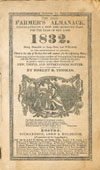 1832 After 39 years, Robert B. Thomas's Farmer's Almanac had outlived all the competition, so he added the word Old to the title (though meekly, in parentheses). Three years later, he inexplicably dropped the word. In 1848, then-Editor John H. Jenks returned Old to the title, securing its place in publishing history.
1832 After 39 years, Robert B. Thomas's Farmer's Almanac had outlived all the competition, so he added the word Old to the title (though meekly, in parentheses). Three years later, he inexplicably dropped the word. In 1848, then-Editor John H. Jenks returned Old to the title, securing its place in publishing history.
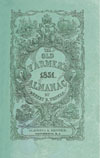 1851 Look familiar? The depiction of the four seasons was introduced in 1851 and has been on the cover of every edition of The Old Farmer's Almanac ever since. Today, most people recognize it when they see this illustration on a yellow background. The tradition of the yellow cover, sadly not visible on our two-color magazine page, didn't begin until more than two decades later.
1851 Look familiar? The depiction of the four seasons was introduced in 1851 and has been on the cover of every edition of The Old Farmer's Almanac ever since. Today, most people recognize it when they see this illustration on a yellow background. The tradition of the yellow cover, sadly not visible on our two-color magazine page, didn't begin until more than two decades later.
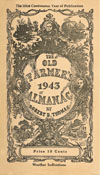 1943 As World War II raged, The Old Farmer's Almanac showed its support by featuring an image of President Franklin D. Roosevelt. This was the first and only time in the history of The Old Farmer's Almanac that anyone else has appeared on the cover with Robert B. Thomas and Benjamin Franklin (who is believed to be the father of the modern almanac). This cover is significant, also, for the first appearance of the phrase "weather indications." Following the capture on Long Island of a German spy who had landed from a U-boat and had a copy of The Old Farmer's Almanac in his pocket, the U.S. government issued a mandate against publishing weather forecasts. The fear was that the enemy would use the predictions to their advantage. Rather than halt publication, Editor Robb Sagendorph added that alternative phrase, saving the Almanac's record of uninterrupted publication.
1943 As World War II raged, The Old Farmer's Almanac showed its support by featuring an image of President Franklin D. Roosevelt. This was the first and only time in the history of The Old Farmer's Almanac that anyone else has appeared on the cover with Robert B. Thomas and Benjamin Franklin (who is believed to be the father of the modern almanac). This cover is significant, also, for the first appearance of the phrase "weather indications." Following the capture on Long Island of a German spy who had landed from a U-boat and had a copy of The Old Farmer's Almanac in his pocket, the U.S. government issued a mandate against publishing weather forecasts. The fear was that the enemy would use the predictions to their advantage. Rather than halt publication, Editor Robb Sagendorph added that alternative phrase, saving the Almanac's record of uninterrupted publication.
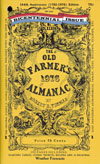 1976 The first edition of The Old Farmer's Almanac was published just 16 years after the United States declared its independence from England. So when America celebrated its bicentennial, out came a special edition, with a red-white-and-blue banner at the top. This year, the price of the Almanac was 75 cents.
1976 The first edition of The Old Farmer's Almanac was published just 16 years after the United States declared its independence from England. So when America celebrated its bicentennial, out came a special edition, with a red-white-and-blue banner at the top. This year, the price of the Almanac was 75 cents.
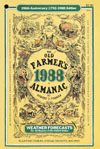 1988 Although The Old Farmer's Almanac had been known as "the little book with the familiar yellow cover" for some time, this year marked the beginning of its full four-color cover design.
1988 Although The Old Farmer's Almanac had been known as "the little book with the familiar yellow cover" for some time, this year marked the beginning of its full four-color cover design.
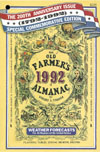 1992 To celebrate 200 years of continuous publication, an expanded version of The Old Farmer's Almanac was released, complete with a large red, white, and blue banner.
1992 To celebrate 200 years of continuous publication, an expanded version of The Old Farmer's Almanac was released, complete with a large red, white, and blue banner.
 2007 For the first time, an offshoot children's version of the Almanac will be offered this summer.
2007 For the first time, an offshoot children's version of the Almanac will be offered this summer.
Believe it or not, historic editions of The Old Farmer's Almanac can be had online affordably. Prices for nineteenth-century editions on abebooks.com varied from $6 to $25 when I checked them recently. Not bad, for a real "slice of history" you can add to your American history studies!
-Mary Pride |
One of the best sources of historical data for the student of American history is the American almanac, that annual compilation of facts and figures for each year of our nation's existence.
Ever since the first almanac was published in New England in 1639, the need to compile data as well as provide a calendar and predict the weather has become a great American tradition. Since that modest beginning in 1639-only nine years after the first Puritan settlers landed at the Massachusetts Bay colony-almanacs soon became part of American daily life, along with Bibles and newspapers. They were particularly needed by farmers in what was then a largely agrarian economy.
Today's almanacs are mini-encyclopedias, packed with statistical data, published until recently by major newspapers. Even the Encyclopedia Britannica produces its own almanac. We use them mainly as a quick reference for facts.
The early almanacs are a delight to read. Yes, they too have lots of statistics on every aspect of American life, but they also have a lot of information about the weather, which is relevant to the present. For example, the American Almanac and Repository of Useful Knowledge for the Year 1836 reports:
"The past winter has been uncommonly severe throughout the country, from Maine to Louisiana, both for the intensity of the cold, and for its long continuance... it will be seen that the mercury fell to 40 degrees below zero, the point of congelation; and the mercury is stated to have actually frozen on the 4th of January, at Bangor, in Maine, and at Montpelier, in Vermont."
In 1842, the American Almanac listed the snow storms observed at Waltham, Massachusetts, a city near Boston in which I live. In the winter of 1840-41, there were 28 snow storms from October 26th to April 13th with an accumulation of 87.25 inches. Today, as of February, 2007, we've only had one snowfall, hardly a storm, with less than two inches of accumulation. In other words, there has been a beneficial warming trend, which is causing great hysterical concern among the prognosticators of climate change.
Almanacs were also published by political parties. The Whigs had their almanacs, and the Anti-Masonic Party had almanacs of their own. The Whig Almanacs had lots of political content: A statement by Henry Clay. An article on the war with Mexico. President Taylor's Inaugural Address on March 5, 1849. A speech by William H. Seward on the Nebraska Bill. Kansas, and the Extension of Slavery. The case of Dred Scott. And much more.
For the young history buff, collecting these almanacs can become a very rewarding hobby and also a great source of reading pleasure. By the way, the articles in these early almanacs are printed in very small type, which seems to indicate that we've also had a global decline in American eyesight! Or maybe they had very strong spectacles.
Where do you find these old almanacs? Antiquarian bookshops are a good place to start. I also found some Whig Almanacs offered on Abebooks.com at very reasonable prices. If you want to find the old American Almanacs, you must type in the years 1800-1900. Otherwise you will have to wade through all sorts of so-called contemporary almanacs published by a great variety of groups.
The term almanac is used very loosely these days. The really good almanacs worth collecting are the genuine ones published in the 19th century. They are the ones filled with detailed meteorological data, governmental statistics, and articles of great historical interest.
Probably the most celebrated of our historical calendars is Poor Richard's Almanac, published by Benjamin Franklin from 1732 to about 1758. Franklin tells us that he "filled all the little spaces that occur'd between the remarkable days in the calendar with proverbial sentences, chiefly such as inculcated industry and frugality, as the means of procuring wealth, and thereby securing virtue." Franklin's readers loved his almanacs, not merely because they were comical, but because his humorous sayings made sense.
If this article gets you interested enough in almanacs so that you want to know more, a good book to start with is Robb Sagendorph's America and her Almanacs, published in 1970. And then start buying old almanacs yourself.